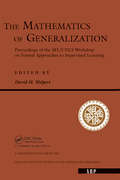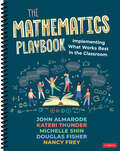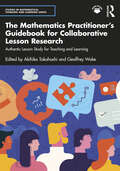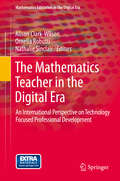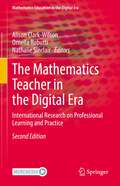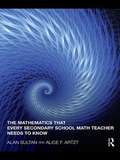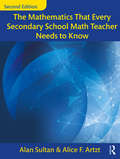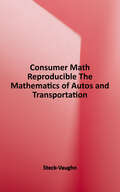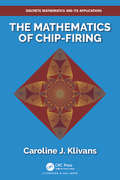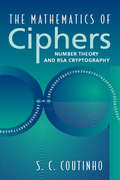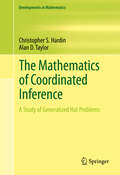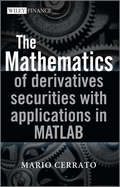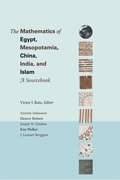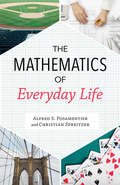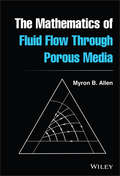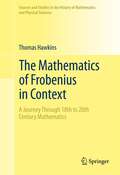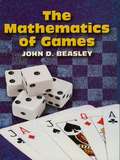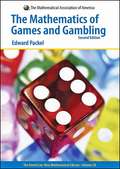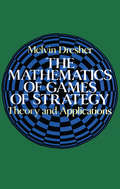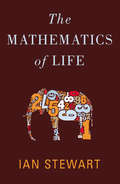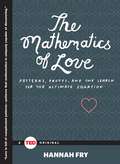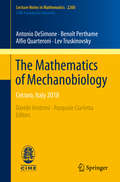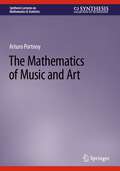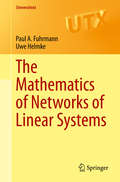- Table View
- List View
The Mathematics Of Generalization: Proceedings: Sfi-cnls Workshop On Formal Approaches To Supervised Learning (1992: Santa Fe, N. M.)
by David. H WolpertThis volume grew out of a workshop designed to bring together researchers from different fields and includes contributions from workers in Bayesian analysis, machine learning, neural nets, PAC and VC theory, classical sampling theory statistics and the statistical physics of learning. The contributions present a bird's-eye view of the subject.
The Mathematics Playbook: Implementing What Works Best in the Classroom
by Douglas Fisher Nancy Frey John T. Almarode Kateri Thunder Michelle ShinYour Guide to Engaging and Effective Math Instruction With the latest research on what works best in teaching and learning, The Mathematics Playbook is your comprehensive guide to enhancing mathematics teaching and learning. With a focus on fostering equity and maximizing student learning, the authors provide practical modules that integrate the latest research on effective teaching practices, and answer four critical questions: How do we foster, nurture, and sustain mathematics learning? How do we ensure all learners have equity of access and opportunity? What are the non-negotiables in a high-quality mathematics task? How do we know if learners really "get it"? Through real-life examples and an emphasis on self-assessment and reflection, this playbook empowers you to create engaging and impactful learning experiences in mathematics.
The Mathematics Playbook: Implementing What Works Best in the Classroom
by Douglas Fisher Nancy Frey John T. Almarode Kateri Thunder Michelle ShinYour Guide to Engaging and Effective Math Instruction With the latest research on what works best in teaching and learning, The Mathematics Playbook is your comprehensive guide to enhancing mathematics teaching and learning. With a focus on fostering equity and maximizing student learning, the authors provide practical modules that integrate the latest research on effective teaching practices, and answer four critical questions: How do we foster, nurture, and sustain mathematics learning? How do we ensure all learners have equity of access and opportunity? What are the non-negotiables in a high-quality mathematics task? How do we know if learners really "get it"? Through real-life examples and an emphasis on self-assessment and reflection, this playbook empowers you to create engaging and impactful learning experiences in mathematics.
The Mathematics Practitioner’s Guidebook for Collaborative Lesson Research: Authentic Lesson Study for Teaching and Learning (Studies in Mathematical Thinking and Learning Series)
by Akihiko Takahashi Geoffrey WakeThis resource provides mathematics educators with tools for conducting Collaborative Lesson Research (CLR), a form of Lesson Study developed out of the original Japanese Lesson Study and intended to improve student and teacher learning. Renowned mathematics education researchers Akihiko Takahashi and Geoffrey Wake bring together educators across the US and UK with first-hand experience using CLR in their schools. Readers will learn the essentials for an impactful Lesson Study directly from the scholars who coined the term, and benefit from the dual perspectives of math education researchers and teachers who have used CLR when reflecting on their own classroom pedagogy. These contributors define CLR and provide examples of successful CLR using real-life case studies, as well as introducing pathways for getting started and practical suggestions for implementation into different school environments. Across these examples, readers will: understand the essence of Lesson Study, considered as CLR, and its important features be advised what participants in CLR should expect to do (observing research lessons, designing lessons, teaching research lessons, facilitating post-lesson discussion, etc.) and provide guidance and support with this enactment be advised on how to develop, embed, and sustain CLR communities preview potential outcomes over time from undertaking CLR Research lesson proposals and plans to support readers in understanding CLR are also included. Ideal for practicing teachers, teacher leaders, teacher educators, and professional developers involved in mathematics teaching, this book offers first-of-its-kind entry points for CLR. Its combination of theory and practice will empower educators to implement this increasingly popular vehicle for understanding students’ learning of mathematics.
The Mathematics Teacher in the Digital Era: An International Perspective on Technology Focused Professional Development (Mathematics Education in the Digital Era #2)
by Nathalie Sinclair Alison Clark-Wilson Ornella RobuttiThis volume addresses the key issue of the initial education and lifelong professional learning of teachers of mathematics to enable them to realize the affordances of educational technology for mathematics. With invited contributions from leading scholars in the field, this volume contains a blend of research articles and descriptive texts.In the opening chapter John Mason invites the reader to engage in a number of mathematics tasks that highlight important features of technology-mediated mathematical activity. This is followed by three main sections:An overview of current practices in teachers’ use of digital technologies in the classroom and explorations of the possibilities for developing more effective practices drawing on a range of research perspectives (including grounded theory, enactivism and Valsiner’s zone theory).A set of chapters that share many common constructs (such as instrumental orchestration, instrumental distance and double instrumental genesis) and research settings that have emerged from the French research community, but have also been taken up by other colleagues.Meta-level considerations of research in the domain by contrasting different approaches and proposing connecting or uniting elements
The Mathematics Teacher in the Digital Era: International Research on Professional Learning and Practice (Mathematics Education in the Digital Era #16)
by Nathalie Sinclair Alison Clark-Wilson Ornella RobuttiThis book brings together international research on school teachers’, and university lecturers’ uses of digital technology to enhance teaching and learning in mathematics. It includes contributions that address theoretical, methodological, and practical challenges for the field with the research lens trained on the perspectives of teachers and teaching. As countries around the world move to integrate digital technologies in classrooms, this book collates research perspectives and experiences that offer valuable insights, in particular concerning the trajectories of development of teachers’ digital skills, knowledge and classroom practices.Via app: download the SN More Media app for free, scan a link with play button and access the videos directly on your smartphone or tablet.
The Mathematics That Every Secondary School Math Teacher Needs to Know
by Alice F. Artzt Alan SultanWhat knowledge of mathematics do secondary school math teachers need to facilitate understanding, competency, and interest in mathematics for all of their students? This unique text and resource bridges the gap between the mathematics learned in college and the mathematics taught in secondary schools. Written in an informal, clear, and interactive learner-centered style, it is designed to help pre-service and in-service teachers gain the deep mathematical insight they need to engage their students in learning mathematics in a multifaceted way that is interesting, developmental, connected, deep, understandable, and often, surprising and entertaining. Features include Launch questions at the beginning of each section, Student Learning Opportunities, Questions from the Classroom, and highlighted themes throughout to aid readers in becoming teachers who have great "MATH-N-SIGHT": M Multiple Approaches/Representations A Applications to Real Life T Technology H History N Nature of Mathematics: Reasoning and Proof S Solving Problems I Interlinking Concepts: Connections G Grade Levels H Honing of Mathematical Skills T Typical Errors This text is aligned with the recently released Common Core State Standards, and is ideally suited for a capstone mathematics course in a secondary mathematics certification program. It is also appropriate for any methods or mathematics course for pre- or in-service secondary mathematics teachers, and is a valuable resource for classroom teachers.
The Mathematics That Every Secondary School Math Teacher Needs to Know (Studies in Mathematical Thinking and Learning Series)
by Alice F. Artzt Alan SultanDesigned to help pre-service and in-service teachers gain the knowledge they need to facilitate students' understanding, competency, and interest in mathematics, the revised and updated Second Edition of this popular text and resource bridges the gap between the mathematics learned in college and the mathematics taught in secondary schools. Highlighting multiple types of mathematical understanding to deepen insight into the secondary school mathematics curriculum, it addresses typical areas of difficulty and common student misconceptions so teachers can involve their students in learning mathematics in a way that is interesting, interconnected, understandable, and often surprising and entertaining. Six content strands are discussed—Numbers and Operations; Algebra; Geometry; Measurement; Data Analysis and Probability; and Proof, Functions, and Mathematical Modeling. The informal, clear style supports an interactive learner-centered approach through engaging pedagogical features: Launch Questions at the beginning of each section capture interest and involve readers in learning the mathematical concepts. Practice Problems provide opportunities to apply what has been learned and complete proofs. Questions from the Classroom bring the content to life by addressing the deep "why" conceptual questions that middle or secondary school students are curious about, and questions that require analysis and correction of typical student errors and misconceptions; focus on counter intuitive results; and contain activities and/or tasks suitable for use with students. Changes in the Second Edition New sections on Robotics, Calculators, Matrix Operations, Cryptography, and the Coefficient of Determination New problems, simpler proofs, and more illustrative examples Answers and hints for selected problems provided
The Mathematics of Automobiles and Transportation (Consumer Math Ser.)
by Steck-VaughnThis very practical series will help adolescents and adults alike to understand mathematics as it relates to their everyday lives. Each book covers basic math concepts and skills before exploring the more specific topics. Clear explanations are followed by ample practice. Each section also has a pretest, a section review, and a posttest.
The Mathematics of Chip-Firing (Discrete Mathematics and Its Applications)
by Caroline J. KlivansThe Mathematics of Chip-firing is a solid introduction and overview of the growing field of chip-firing. It offers an appreciation for the richness and diversity of the subject. Chip-firing refers to a discrete dynamical system — a commodity is exchanged between sites of a network according to very simple local rules. Although governed by local rules, the long-term global behavior of the system reveals fascinating properties. The Fundamental properties of chip-firing are covered from a variety of perspectives. This gives the reader both a broad context of the field and concrete entry points from different backgrounds. Broken into two sections, the first examines the fundamentals of chip-firing, while the second half presents more general frameworks for chip-firing. Instructors and students will discover that this book provides a comprehensive background to approaching original sources. Features: Provides a broad introduction for researchers interested in the subject of chip-firing The text includes historical and current perspectives Exercises included at the end of each chapter About the Author: Caroline J. Klivans received a BA degree in mathematics from Cornell University and a PhD in applied mathematics from MIT. Currently, she is an Associate Professor in the Division of Applied Mathematics at Brown University. She is also an Associate Director of ICERM (Institute for Computational and Experimental Research in Mathematics). Before coming to Brown she held positions at MSRI, Cornell and the University of Chicago. Her research is in algebraic, geometric and topological combinatorics.
The Mathematics of Ciphers: Number Theory and RSA Cryptography
by S.C. CoutinhoThis book is an introduction to the algorithmic aspects of number theory and its applications to cryptography, with special emphasis on the RSA cryptosys-tem. It covers many of the familiar topics of elementary number theory, all with an algorithmic twist. The text also includes many interesting historical notes.
The Mathematics of Coordinated Inference
by Christopher S. Hardin Alan D. TaylorTwo prisoners are told that they will be brought to a room and seated so that each can see the other. Hats will be placed on their heads; each hat is either red or green. The two prisoners must simultaneously submit a guess of their own hat color, and they both go free if at least one of them guesses correctly. While no communication is allowed once the hats have been placed, they will, however, be allowed to have a strategy session before being brought to the room. Is there a strategy ensuring their release? The answer turns out to be yes, and this is the simplest non-trivial example of a "hat problem. " This book deals with the question of how successfully one can predict the value of an arbitrary function at one or more points of its domain based on some knowledge of its values at other points. Topics range from hat problems that are accessible to everyone willing to think hard, to some advanced topics in set theory and infinitary combinatorics. For example, there is a method of predicting the value f(a) of a function f mapping the reals to the reals, based only on knowledge of f's values on the open interval (a - 1, a), and for every such function the prediction is incorrect only on a countable set that is nowhere dense. The monograph progresses from topics requiring fewer prerequisites to those requiring more, with most of the text being accessible to any graduate student in mathematics. The broad range of readership includes researchers, postdocs, and graduate students in the fields of set theory, mathematical logic, and combinatorics. The hope is that this book will bring together mathematicians from different areas to think about set theory via a very broad array of coordinated inference problems.
The Mathematics of Derivatives Securities with Applications in MATLAB
by Mario CerratoQuantitative Finance is expanding rapidly. One of the aspects of the recent financial crisis is that, given the complexity of financial products, the demand for people with high numeracy skills is likely to grow and this means more recognition will be given to Quantitative Finance in existing and new course structures worldwide. Evidence has suggested that many holders of complex financial securities before the financial crisis did not have in-house experts or rely on a third-party in order to assess the risk exposure of their investments. Therefore, this experience shows the need for better understanding of risk associate with complex financial securities in the future. The Mathematics of Derivative Securities with Applications in MATLAB provides readers with an introduction to probability theory, stochastic calculus and stochastic processes, followed by discussion on the application of that knowledge to solve complex financial problems such as pricing and hedging exotic options, pricing American derivatives, pricing and hedging under stochastic volatility and an introduction to interest rates modelling. The book begins with an overview of MATLAB and the various components that will be used alongside it throughout the textbook. Following this, the first part of the book is an in depth introduction to Probability theory, Stochastic Processes and Ito Calculus and Ito Integral. This is essential to fully understand some of the mathematical concepts used in the following part of the book. The second part focuses on financial engineering and guides the reader through the fundamental theorem of asset pricing using the Black and Scholes Economy and Formula, Options Pricing through European and American style options, summaries of Exotic Options, Stochastic Volatility Models and Interest rate Modelling. Topics covered in this part are explained using MATLAB codes showing how the theoretical models are used practically. Authored from an academic's perspective, the book discusses complex analytical issues and intricate financial instruments in a way that it is accessible to postgraduate students with or without a previous background in probability theory and finance. It is written to be the ideal primary reference book or a perfect companion to other related works. The book uses clear and detailed mathematical explanation accompanied by examples involving real case scenarios throughout and provides MATLAB codes for a variety of topics.
The Mathematics of Egypt, Mesopotamia, China, India, and Islam: A Sourcebook
by Kim Plofker Annette Imhausen Joseph Warren Dauben J. Lennart Berggren Eleanor RobsonIn recent decades it has become obvious that mathematics has always been a worldwide activity. But this is the first book to provide a substantial collection of English translations of key mathematical texts from the five most important ancient and medieval non-Western mathematical cultures, and to put them into full historical and mathematical context. The Mathematics of Egypt, Mesopotamia, China, India, and Islam gives English readers a firsthand understanding and appreciation of these cultures' important contributions to world mathematics. The five section authors--Annette Imhausen (Egypt), Eleanor Robson (Mesopotamia), Joseph Dauben (China), Kim Plofker (India), and J. Lennart Berggren (Islam)--are experts in their fields. Each author has selected key texts and in many cases provided new translations. The authors have also written substantial section introductions that give an overview of each mathematical culture and explanatory notes that put each selection into context. This authoritative commentary allows readers to understand the sometimes unfamiliar mathematics of these civilizations and the purpose and significance of each text. Addressing a critical gap in the mathematics literature in English, this book is an essential resource for anyone with at least an undergraduate degree in mathematics who wants to learn about non-Western mathematical developments and how they helped shape and enrich world mathematics. The book is also an indispensable guide for mathematics teachers who want to use non-Western mathematical ideas in the classroom.
The Mathematics of Everyday Life
by Alfred S. Posamentier Christian SpreitzerTwo experienced math educators help the average reader discover not only the everyday usefulness of math but the fun that comes from mastering the basics of arithmetic, algebra, geometry, and more.If you think of mathematics as a series of pointless classroom exercises without much relevance to real life, this book will change your mind. As the authors show, math is deeply embedded in almost every aspect of daily life--from managing your personal finances, making consumer purchases, and sharpening your computational skills, to learning to apply mathematical concepts that will give you a better grasp of both ordinary and extraordinary events and help you better appreciate the world we live in. With some basic geometry under your belt, you'll discover that there is an optimal point on a soccer field from which to shoot a goal. And you'll be more clever with the gears of a bike. If you like to play cards or go to the casino, knowing something about probability will give you an edge. You'll also have an enhanced understanding of the "whispering effect" inside the Capitol rotunda, why a car's headlights are so bright, and even why sewer covers are round. After reading this entertaining and instructive book, you'll come away with a whole new awareness of how elegantly mathematics explains everyday experiences and observations--from present day items to classical art and architecture.
The Mathematics of Fluid Flow Through Porous Media
by Myron B. Allen IIIMaster the techniques necessary to build and use computational models of porous media fluid flow In The Mathematics of Fluid Flow Through Porous Media, distinguished professor and mathematician Dr. Myron B. Allen delivers a one-stop and mathematically rigorous source of the foundational principles of porous medium flow modeling. The book shows readers how to design intelligent computation models for groundwater flow, contaminant transport, and petroleum reservoir simulation. Discussions of the mathematical fundamentals allow readers to prepare to work on computational problems at the frontiers of the field. Introducing several advanced techniques, including the method of characteristics, fundamental solutions, similarity methods, and dimensional analysis, The Mathematics of Fluid Flow Through Porous Media is an indispensable resource for students who have not previously encountered these concepts and need to master them to conduct computer simulations. Teaching mastery of a subject that has increasingly become a standard tool for engineers and applied mathematicians, and containing 75 exercises suitable for self-study or as part of a formal course, the book also includes: A thorough introduction to the mechanics of fluid flow in porous media, including the kinematics of simple continua, single-continuum balance laws, and constitutive relationships An exploration of single-fluid flows in porous media, including Darcy’s Law, non-Darcy flows, the single-phase flow equation, areal flows, and flows with wells Practical discussions of solute transport, including the transport equation, hydrodynamic dispersion, one-dimensional transport, and transport with adsorption A treatment of multiphase flows, including capillarity at the micro- and macroscale Perfect for graduate students in mathematics, civil engineering, petroleum engineering, soil science, and geophysics, The Mathematics of Fluid Flow Through Porous Media also belongs on the bookshelves of any researcher who wishes to extend their research into areas involving flows in porous media.
The Mathematics of Frobenius in Context: A Journey Through 18th to 20th Century Mathematics
by Thomas HawkinsFrobenius made many important contributions to mathematics in the latter part of the 19th century. Hawkins here focuses on his work in linear algebra and its relationship with the work of Burnside, Cartan, and Molien, and its extension by Schur and Brauer. He also discusses the Berlin school of mathematics and the guiding force of Weierstrass in that school, as well as the fundamental work of d'Alembert, Lagrange, and Laplace, and of Gauss, Eisenstein and Cayley that laid the groundwork for Frobenius's work in linear algebra. The book concludes with a discussion of Frobenius's contribution to the theory of stochastic matrices.
The Mathematics of Games
by John D. BeasleyIf playing games is natural for humans, analyzing games is equally natural for mathematicians. Even the simplest of games involves the fundamentals of mathematics, such as figuring out the best move or the odds of a certain chance event. This entertaining and wide-ranging guide demonstrates how simple mathematical analysis can throw unexpected light on games of every type--games of chance, games of skill, games of chance and skill, and automatic games.Just how random is a card shuffle or a throw of the dice? Is bluffing a valid poker strategy? How can you tell if a puzzle is unsolvable? How large a role does luck play in games like golf and soccer? This book examines each of these issues and many others, along with the general principles behind such classic puzzles as peg solitaire and Rubik's cube. Lucid, instructive, and full of surprises, it will fascinate mathematicians and gamesters alike.
The Mathematics of Games and Gambling (Anneli Lax New Mathematical Library #28)
by Edward W. Packel<p>The first edition of this book was reprinted eight times. This book introduces and develops some of the important and beautiful elementary mathematics needed for rational analysis of various gambling and game activities. Most of the standard casino games (roulette, blackjack, keno), some social games (backgammon, poker, bridge) and various other activities (state lotteries, horse racing, etc.) are treated in ways that bring out their mathematical aspects. The mathematics developed ranges from the predictable concepts of probability, expectation, and binomial coefficients to some less well-known ideas of elementary game theory. The second edition includes new material on: sports betting and the mathematics behind it; Game theory applied to bluffing in poker and related to the Texas Holdem phenomenon; The Nash equilibrium concept and its emergence in the popular culture; Internet links to games and to Java applets for practice and classroom use. <p>The only formal mathematics background the reader needs is some facility with high school algebra. Game-related exercises are included at the end of most chapters for readers interested in working with and expanding ideas treated in the text. Solutions to some of the exercises appear at the end of the book.</p>
The Mathematics of Games of Strategy: Theory And Applications (Dover Books on Mathematics)
by Melvin DresherMelvin Dresher, noted research mathematician for the Rand Corporation, puts forth an exceptionally clear presentation of the mathematical theory of games of strategy and its applications to many fields including: economics, military, business, and operations research. The mathematical presentation is elementary in the sense that no advanced algebra or non-elementary calculus occurs in most of the mathematical proofs.The author presents game theory as a branch of applied mathematics. In addition to developing a mathematical theory for solving games, he shows how to formulate a game model associated with a given competitive or conflicting situation. Furthermore, he shows how some decision problems, such as timing of decisions, which do not resemble game situations, can be analyzed as a game, yielding rich insights into the decision problems.Beginning with an exposition of games of strategy, with examples from parlor games as well as military games, Dr. Dresher proceeds to treat the basic topics in the theory of finite games, i.e., the existence of optimal strategies and their properties. An elementary proof of the minimax theorem is given that provides an efficient method for computing optimal strategies.Since many games involve an infinite number of strategies, succeeding chapters deal with such games by first developing the necessary mathematics (e.g., probability distribution functions and Stieltjes integrals) for analyzing infinite games. The results of infinite games are then applied to two general classes of games — timing games and tactical games. A final chapter provides an application of moment space theory to the solution of infinite games.This is a book about decision making in the absence of perfect information. In particular, it analyzes decision problems in a competitive environment where conflicting interests exist, and uncertainties and risk are involved. For the reader who is interested in the applications of the theory of games of strategy to military, economic, or political problems, or to decision making in business, operations research, or the behavior sciences, it will prove a most rewarding study.
The Mathematics of Life: The New Mathematics Of The Living World
by Ian StewartBiologists have long dismissed mathematics as being unable to meaningfully contribute to our understanding of living beings. Within the past ten years, however, mathematicians have proven that they hold the key to unlocking the mysteries of our world--and ourselves. In The Mathematics of Life, Ian Stewart provides a fascinating overview of the vital but little-recognized role mathematics has played in pulling back the curtain on the hidden complexities of the natural world--and how its contribution will be even more vital in the years ahead. In his characteristically clear and entertaining fashion, Stewart explains how mathematicians and biologists have come to work together on some of the most difficult scientific problems that the human race has ever tackled, including the nature and origin of life itself.
The Mathematics of Love: Patterns, Proofs, and the Search for the Ultimate Equation (TED Books)
by Hannah FryIn this must-have for anyone who wants to better understand their love life, a mathematician pulls back the curtain and reveals the hidden patterns—from dating sites to divorce, sex to marriage—behind the rituals of love.The roller coaster of romance is hard to quantify; defining how lovers might feel from a set of simple equations is impossible. But that doesn’t mean that mathematics isn’t a crucial tool for understanding love. Love, like most things in life, is full of patterns. And mathematics is ultimately the study of patterns—from predicting the weather to the fluctuations of the stock market, the movement of planets or the growth of cities. These patterns twist and turn and warp and evolve just as the rituals of love do. In The Mathematics of Love, Dr. Hannah Fry takes the reader on a fascinating journey through the patterns that define our love lives, applying mathematical formulas to the most common yet complex questions pertaining to love: What’s the chance of finding love? What’s the probability that it will last? How do online dating algorithms work, exactly? Can game theory help us decide who to approach in a bar? At what point in your dating life should you settle down? From evaluating the best strategies for online dating to defining the nebulous concept of beauty, Dr. Fry proves—with great insight, wit, and fun—that math is a surprisingly useful tool to negotiate the complicated, often baffling, sometimes infuriating, always interesting, mysteries of love.
The Mathematics of Mechanobiology: Cetraro, Italy 2018 (Lecture Notes in Mathematics #2260)
by Benoît Perthame Alfio Quarteroni Lev Truskinovsky Antonio DeSimoneThis book presents the state of the art in mathematical research on modelling the mechanics of biological systems – a science at the intersection between biology, mechanics and mathematics known as mechanobiology. The book gathers comprehensive surveys of the most significant areas of mechanobiology: cell motility and locomotion by shape control (Antonio DeSimone); models of cell motion and tissue growth (Benoît Perthame); numerical simulation of cardiac electromechanics (Alfio Quarteroni); and power-stroke-driven muscle contraction (Lev Truskinovsky).Each section is self-contained in terms of the biomechanical background, and the content is accessible to all readers with a basic understanding of differential equations and numerical analysis. The book disentangles the phenomenological complexity of the biomechanical problems, while at the same time addressing the mathematical complexity with invaluable clarity. The book is intended for a wide audience, in particular graduate students and applied mathematicians interested in entering this fascinating field.
The Mathematics of Music and Art (Synthesis Lectures on Mathematics & Statistics)
by Arturo PortnoyThis book explores the relationships between music, the sciences, and mathematics, both ancient and modern, with a focus on the big picture for a general audience as opposed to delving into very technical details. The language of music is deciphered through the language of mathematics. Readers are shown how apparently unrelated areas of knowledge complement each other and in fact propel each other’s advancement. The presentation as well as the collection of topics covered throughout is unique and serves to encourage exploration and also, very concretely, illustrates the cross- and multidisciplinary nature of knowledge. Inspired by an introductory, multidisciplinary course, the author explores the relationships between the arts, sciences, and mathematics in the realm of music. The book has no prerequisites; rather it aims to give a broad overview and achieve the integration of the three presented themes. Mathematical tools are introduced and used to explain various aspects of music theory, and the author illustrates how, without mathematics, music could not have been developed.
The Mathematics of Networks of Linear Systems
by Paul A. Fuhrmann Uwe HelmkeThis book provides the mathematical foundations of networks of linear control systems, developed from an algebraic systems theory perspective. This includes a thorough treatment of questions of controllability, observability, realization theory, as well as feedback control and observer theory. The potential of networks for linear systems in controlling large-scale networks of interconnected dynamical systems could provide insight into a diversity of scientific and technological disciplines. The scope of the book is quite extensive, ranging from introductory material to advanced topics of current research, making it a suitable reference for graduate students and researchers in the field of networks of linear systems. Part I can be used as the basis for a first course in Algebraic System Theory, while Part II serves for a second, advanced, course on linear systems. Finally, Part III, which is largely independent of the previous parts, is ideally suited for advanced research seminars aimed at preparing graduate students for independent research. "Mathematics of Networks of Linear Systems" contains a large number of exercises and examples throughout the text making it suitable for graduate courses in the area.
